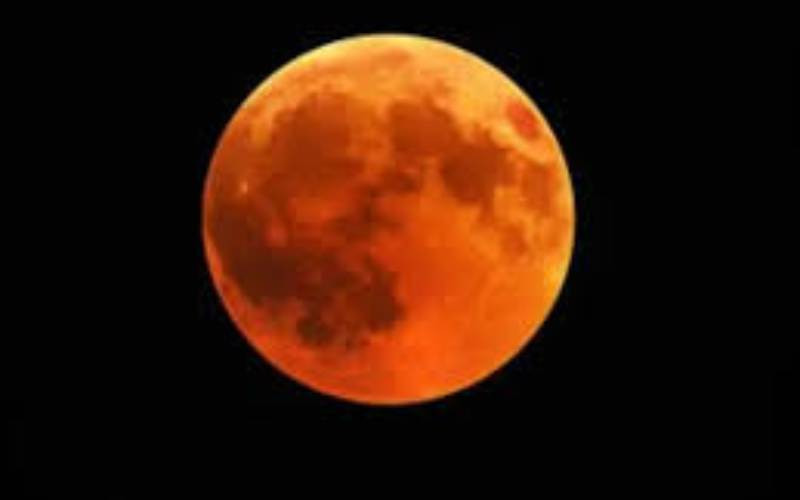Kenya Gazes Up: Rare Blood Moon Eclipse Ignites Astro-Tourism Boom and Cultural Wonder

On Sunday, September 7, 2025, sky-gazers across Kenya and much of Africa witnessed a captivating celestial spectacle: a total lunar eclipse, popularly known as the "Blood Moon." This phenomenon occurs when the Earth positions itself directly between the Sun and the Moon, casting its shadow across the lunar surface. As sunlight bends through Earth’s atmosphere, the Moon takes on an ethereal deep red or coppery glow, a sight that has intrigued humanity for millennia.
The total lunar eclipse unfolded in distinct stages for observers in Kenya. It began with a penumbral eclipse at approximately 6:28 p.m. in Nairobi, a subtle shading as the Moon entered Earth’s outer shadow. This was followed by a more noticeable partial eclipse starting at 7:27 p.m., as the Moon progressively darkened from one side. The dramatic total eclipse phase commenced at 8:31 p.m., where the Moon's bright light vanished, replaced by its distinctive red hue. The maximum eclipse, lasting about 41 minutes, occurred at 9:12 p.m., with the Moon entirely enveloped in Earth's darkest shadow, glowing in shades from vivid red to dusky orange or even brownish grey depending on atmospheric conditions. The total eclipse concluded around 10:56 p.m., with the partial and penumbral phases gradually receding until the Moon resumed its full brilliance by 11:55 p.m. The entire celestial show lasted over five hours, with the striking red moon visible for approximately one hour and 22 minutes at its peak. Unlike solar eclipses, viewing a lunar eclipse is completely safe with the naked eye, requiring no special glasses or filters, and the event was fully visible across Kenya.
Coinciding with this spectacular event, Kenya launched its first dedicated Astro-tourism experience, marking a significant expansion of its tourism offerings. The pioneering initiative, graced by Tourism and Wildlife Cabinet Secretary Rebecca Miano, took place at Sopa Lodge in Samburu National Reserve in Samburu County. Samburu was chosen for its remote, protected environment, boasting some of the world's darkest skies with minimal light pollution and clear equatorial views, making it an ideal location for observing celestial events like the Milky Way, constellations, and meteor showers. Other locations across Kenya, including Waterfront in Karen (Nairobi), The Landing in Nanyuki, Ileret Campus of Turkana Basin Institute, and Fort Place Grill in Kabete (Kiambu County), also hosted enthusiasts for this rare lunar event.
The rise of astro-tourism reflects a global surge in interest in celestial wonders among astronomy enthusiasts and adventure travellers. Kenya, strategically located along the equator with pristine skies and nearly equal night-day hours year-round, is uniquely positioned to unlock the potential of this new frontier. This diversification is expected to generate new jobs for local guides and hospitality workers, promote community-led tourism projects preserving cultural heritage, stimulate investment in infrastructure and environmental conservation, and elevate Kenya’s appeal in high-value niche markets for eco-tourists and astronomy enthusiasts. The catalogue assembled by Magical Kenya for astro-tourism includes guided night sky tours led by experts, astrophotography expeditions, educational workshops, and starlit camp experiences. The initiative also enriches visitor experiences by integrating the indigenous astronomical knowledge of Samburu communities and allowing for combinations with daytime wildlife safaris and nature walks, expanding Kenya’s tourism footprint beyond traditional safari circuits, pristine beaches, and cultural tourism.
The event drew a diverse crowd of foreign tourists and local observers, eager to gaze through telescopes at the reddening moon and surrounding stars. Visitors like Stella-Maris Miriti from Nairobi and Maggie Debbe from Australia expressed awe at the experience. Officials, including Jacques Matara, the Kenya Space Agency’s deputy director of Space Research and Innovation, highlighted Kenya’s advantage of having some of the clearest skies worldwide and emphasized astro-tourism’s potential as a "game-changer" for the tourism sector, creating awareness about the utility of space for socio-economic development. With tourism already accounting for almost 10% of Kenya's GDP and the country benefiting from low light pollution levels (as measured by the Bortle dark-sky scale), astro-tourism presents a significant opportunity for growth.
Beyond its visual grandeur, the Blood Moon on September 7, 2025, evoked a blend of ancient cultural interpretations and modern scientific understanding. Across various African communities, lunar eclipses have historically inspired deep-seated beliefs. For instance, the Samburu of Kenya regard it as an unfavourable period, suspending celebrations until cosmic balance is restored. The Maasai interpret it as a celestial struggle where a spirit "swallows" the moon, prompting shaming chants. Along Kenya's coast, some tribes view eclipses as potent omens of misfortune, forbidding activities like cooking and childbirth and necessitating ritual cleansing. In West Africa, the Yoruba perceive it as a quarrel between cosmic siblings, requiring prayers for harmony, while the Bambara and Dogon of Mali see eclipses as profound thresholds for ancestral communication.
In contrast to these age-old myths, modern science encourages eclipse-watching with curiosity, affirming its safety for the naked eye. From a scientific perspective, a lunar eclipse serves as a natural laboratory for discovery. During totality, the sunlight reaching the Moon is filtered and refracted through Earth’s atmosphere, allowing scientists to analyze this tinted light to detect atmospheric gases, dust content, and even pollutants. These observations significantly contribute to climate models and our understanding of atmospheric behavior. The soft red illumination also highlights subtle lunar surface features, aiding in geological mapping and refining knowledge about the Moon’s composition. Furthermore, the precise alignment of Earth, Moon, and Sun during an eclipse is invaluable for orbital mechanics, enabling astronomers to sharpen calculations of Earth-Moon distance, orbital tilts, and gravitational forces. Historically, predictable events like eclipses, such as the 18-year, 11-day Saros cycle, were crucial for timekeeping and calendar refinement in ancient civilizations. Thus, while a total lunar eclipse captivates the public as a spectacular event, for scientists, it remains a vital gateway into unraveling secrets about our atmosphere, our nearest celestial neighbor, and the intricate orbital choreography of our cosmos.
You may also like...
Culture Shift at Nottingham Forest: Nuno Sacked, Ex-Australia Coach Set to Take Reins!

Nottingham Forest has dramatically shifted its managerial direction, sacking Nuno Espirito Santo, who led them to Europe...
Super Eagles' World Cup Dreams on the Line: Osimhen Injury, Mokoena Controversy Mar South Africa Showdown!

Nigeria's Super Eagles face a do-or-die World Cup qualifier against South Africa, complicated by star striker Victor Osi...
Emmy Glory: Creative Arts Awards Crown 'Severance,' 'The Penguin,' and 'SNL50' with Major Wins

The Creative Arts Emmy Awards celebrated outstanding achievements in television, with Apple TV+'s "The Studio" and HBO M...
Horror Sensation: 'The Conjuring: Last Rites' Unleashes Global Box Office Terror and Spine-Tingling Reviews

“The Conjuring: Last Rites” delivers a record-breaking global box office debut, cementing its place as the highest-gross...
African Music Crowns Its Best: Burna Boy, Davido Lead Star-Studded AFRIMA 2025 Nominations!

The 2025 All Africa Music Awards (AFRIMA) unveil a record-breaking nominations list, with Nigerian superstars Burna Boy ...
Blockbuster Showdown: 2025 MTV VMAs Reveals Performers, Presenters, and Shocking Winners List!

The 2025 MTV Video Music Awards, hosted by LL COOL J, celebrated music's biggest stars with Lady Gaga dominating the nig...
Oasis Reunion Chaos: Watchdog Threats, Line-Up Drama, and Escalating Feuds Plague Iconic Band's Return

Oasis is embarking on a highly anticipated reunion tour in 2025, with Andy Bell confirming his return to the band's line...
Explosive Allegations Rock Alexander Brothers: Accusers Detail Assaults as Lawyers Deny Claims

Luxury real estate moguls Oren, Alon, and Tal Alexander are accused by over 60 victims of rape and sexual assault, with ...

